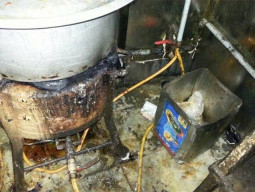
The people of Hyderabad are being supplied contaminated drinking water with high levels of coloured organic matter and turbidity, according to a laboratory report submitted in court, on Saturday.
The report also mentions equipment and facilities that do not work, such as the chlorination plant at the New Filtration Plant, Jamshoro Road, which supplies water to the city.
The district and sessions judge, Amjad Ali Bohyo, had ordered an inspection of the plant, which supplies up to 50 million gallons of water per day, and an analysis of the water samples. Acting on the complaint of a social activist and political worker, Mehboob Abro, the judge assigned the inquiry to DSP Police Telecommunication Sirajuddin Lashari, on August 1.
Water samples
The inquiry officer collected samples from the filtration plant and a private residence in the Nasim Nagar area of Qasimabad. The samples were sent for testing to the Aga Khan University Hospital (AKUH) and Pakistan Council of Research in Water Resources.
According to the results, turbidity, a measure of water clarity, at the plant was 13 Nephelometric Turbidity Units (NTU), and 77 NTU at the private residence. The World Health Organisation’s standard allows only 5 NTU. The pH, TDS, fluoride, arsenic, microbiological contamination and other levels were all found to be under the permissible limits.
The AKUH found the presence of the Colony Count, a measurement of the growth of bacteria and coliforms and bacterial indicators of pathogenic organisms, satisfactory in the plant’s sample but unsatisfactory in the Nasim Nagar sample. The colony count was measured at 5,700 cfu/ml against the WHO standard of 500 cfu/ml.
Plant components
One of the main components of water purification, the chlorination plant, has not been operating for several months, the report stated. It notes that the component is essential for sterilisation of water. One of the reasons behind the supply of turbid water is the excess water the plant is receiving from the canal as only one of the six ‘sludge pumps’ is working. These pumps throw back the excessive water pouring into the clarifiers from the canal.
The plant has three clarifiers which have a capacity of 10 MGD each. They are equipped with eight pumps which suck water from the canal and into the clarifiers. According to the report, two of these pumps are out of order but this has not affected the process of drawing water from the canal. It also found that one of the 18 valves in the filter beds, which store bleached and chlorinated water coming through the channel from clarifiers, was not working.
Water and Sanitation Agency
WASA officials made no excuses when admitting to the quality of water being supplied to the city. “Old machinery, financial stringency and a supply of almost double the quantity of installed capacity, this is what we have to deal with,” said an officer. He added that it’s difficult to maintain a balance between quality and quantity, especially with the help of the old filtration plant and a lack of funds to overhaul it. “The plant was installed with a 30 MGD capacity in 1991, but now with this old system we have to meet the needs of the city which are between 50 to 60 MGD,” he told The Express Tribune.
According to the SDO of the plant, Zeeshan Malik, the chlorination system choked over a month ago due to the accumulation of chlorine sediment. He said that WASA needed technical help to clean the clogged water pipes. Similarly, a sum of at least Rs100,000 will be required to install new sludge pumps, he told The Express Tribune. According to him, the plant will have an expenditure of at least Rs100,000 per day including, Rs50,000 for alum and Rs15,000 for chlorine to ensure the supply of filtered water to the city. They lack funds, however, to meet these expenses and as a result the water quality is compromised.
WASA has been going through a financial crunch as its monthly expenses and salary components exceed Rs40 million, while its recovery of utility bills is around Rs20 million. The agency has been seeking bailouts to meet its urgent needs and its payables from the provincial government.
“The water purification, supply and drainage woes will not end unless the government addresses WASA’s financial problems on a long-term basis.” said an officer. One of the proposals is to convert it into a water board and another suggests reverting to the practice of subsidising the agency as done till the early 1990s.
Published in The Express Tribune, August 12th, 2012.
COMMENTS (1)
Comments are moderated and generally will be posted if they are on-topic and not abusive.
For more information, please see our Comments FAQ



1732626034-0/BeFunky-collage-(92)1732626034-0-165x106.webp)













Its good that Mr. Z Ali, wrote this comprehensive report on the extremely poor condition of potable water being supplied to the people of Hyderabad by Water & Sewerage Authority (WASA). Hyderabad Water Filter Plant is supplying contaminated water without chlorination to the end user, resulting in Fungus growth at the tap outlets. WASA was aware of its shortcomings since 2006. Study of Water Quality carried by EPA, Sindh in 2006, clearly pointed out the high growth of coliforms ( >110 MPN). In 2007, study carried out by Pakistan Council of Research in Water Resources (PCRWR) pointed to the excessive turbidity and consequent bacteriological contamination. It looks that WASA did not take any remedial measures to overcome their short comings and kept supplying polluted water full of microorganism contamination to Hyderabad public till this report by Z. Ali. I am not sure how many people have succumbed, fell ill or died due to water born diseases in Hyderabad, in that long span of time and the responsibility falls squarely on the shoulders of WASA officials.